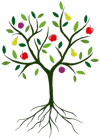Pitmaston Pine Apple
Pitmaston Pine Apple is an 18th century English apple, best-known for its distinctive pineapple-like flavour.
It is thought to be a seedling of Golden Pippin, and certainly appears to have inherited the fruity flavour of that variety.
The apples are very small, not much bigger than crab-apples.
Pitmaston Pine Apple apple trees for sale
RF11-year bare-root
tree
on MM106 rootstock£34.95
Mature height: 3m-5m after 10 years
Can be trained on as a large free-standing apple tree, a half-standard apple tree, a large apple fan or espalier, or a pleached apple tree. Available next season
RF21-year bare-root
tree
on M25 rootstock£35.75
Mature height: 5m-7m after 10 years
Can be trained on to produce a big 'standard' free-standing apple tree in a traditional apple orchard. Available next season
Growing and Training
Pitmaston Pine Apple is generally easy to grow. It has a reputation for variable cropping, but in a good year qualifies as a heavy cropper.
Recommended pollinators for Pitmaston Pine Apple apple trees
Pitmaston Pine Apple is not self-fertile, so you will need another different but compatible variety planted nearby in order to produce fruit.
The following varieties are good pollinators for Pitmaston Pine Apple.
If you are not sure about pollination requirements don't hesitate to ask us.
Ellison's OrangeEllison's Orange is a well respected Cox-style apple which can achieve very good flavour.
BraeburnBraeburn is one of the best-flavoured supermarket apple varieties.
GalaGala is popular supermarket apple - but better when home-grown, with a sweet pleasant flavour.
Newton WonderA traditional English cooking apple, a good alternative to Bramley.
King of the PippinsA popular and versatile dual-purpose apple, widely grown in the Victorian era.
John DownieJohn Downie is a traditional crab apple for making crab apple jelly. White blossom and orange-red fruits.
Peasgood's NonsuchPeasgood Nonsuch is a highly-regarded old-fashioned English cooking apple.
Golden HornetMalus Golden Hornet is a traditional white blossom crab apple, with persistent yellow fruits.
History
Pitmaston Pine was raised by Mr White, the steward to Lord Foley of Witley in the 1780s. It is a seedling of Golden Pippin, a popular English apple of the period. It was introduced by Mr Williams of Pitmaston near Worcester.
Pitmaston Pine Apple characteristics
- Gardening skillAverage
- Self-fertile?Not self-fertile
- Pollinating othersAverage
- Pick seasonLate
- Keeping2-3 weeks
- Food usesEating freshJuice
- Country of originUnited Kingdom
- Period of origin1750 - 1799
- Fruit colourGreen / Yellow
You might also like these varieties
Ashmead's KernelA versatile English 17th century russet apple, Ashmead's Kernel is noted for its distinctive pear-like flavour.
Yellow IngestrieOne of the prettiest of all apples, perfect for a table display, with a rich fruity flavour.
More about apple trees
Apples are very versatile, and all varieties can be eaten or used in the kitchen. However varieties specifically grown as eating apples tend to have the best flavours for eating raw.
The main thing to decide when choosing an eating apple is when you intend to eat the apples. Early season apples are typically ready in August, and generally don't keep very long. Mid-season apples are ripe in early September, while late-season apples start to become ripe in late September and October. Many of the late-season varieties can also be stored in a fridge or cold shed for several months into the winter.
Some apple varieties are self-fertile, but most are not. However in most areas of the UK you do not need to worry whether your apple trees are self-fertile or not, as there will be other apple trees in nearby gardens to help with pollination.
